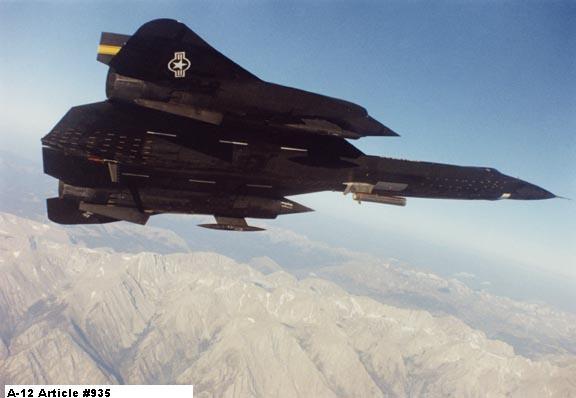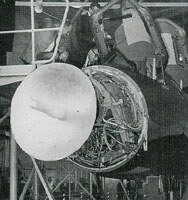


 |
 |
 |

The Lockheed YF-12A Mach 3 interceptor of the mid-1960s had its origin in the top-secret A-12 spyplane which had been designed by Lockheed at Central Intelligence Agency request  as
a successor to the U-2 spyplane.
as
a successor to the U-2 spyplane.
The YF-12 was initially designed as an interceptor prototype equipped with a Hughes AN/ASG-18 pulse-Doppler radar in the nose and tandem weapons bays for three to eight AIM-47 air-to-air missiles, later used by NASA as Mach 3 research aircraft; 3 built (2 lost)
The YF-12A was quite similar in overall configuration to the A-12 from which it was derived. It differed from the A-12 primarily in having a second crewman in a position immediately behind the pilot This second crewman was added to operate the extremely powerful and capable Hughes AN/ASG-18 pulse Doppler fire control radar, which had originally been developed for the F-108 Rapier. The AN/ASG-18 was installed in the extreme nose of the aircraft, with the forward chines being cut back to accommodate the 40-inch radome. The ASG-18 radar supposedly had a search range as great as 500 miles. Infrared sensors were installed in the forward edges of the cut-back chines.
The YF-12A also differed from the A-12 in having armament. This armament consisted of four Hughes AIM-47A Falcon air-to-air missiles housed internally in chine bays that had previously been used to carry the reconnaissance equipment. The AIM-47A had originally been known as  the GAR-9 and (like the ASG-18 radar) had originally been intended for the F-108 Rapier. When fired, the Falcon missiles were explosively ejected from their bays, and their rocket motors were fired. Powered by solid rocket propulsion from Lockheed's propulsion division in Redlands, CA, the AIM-47A had a maximum speed of Mach 6 and an interception range of 115 miles. It had a launch weight of about 800 pounds. The missile relied on semiactive radar homing for midcourse guidance to the immediate vicinity of the target, homing in on reflections off the target resulting from transmissions from the huge ASG-18 radar. The AIM-47 could carry a 250-kiloton nuclear warhead.
the GAR-9 and (like the ASG-18 radar) had originally been intended for the F-108 Rapier. When fired, the Falcon missiles were explosively ejected from their bays, and their rocket motors were fired. Powered by solid rocket propulsion from Lockheed's propulsion division in Redlands, CA, the AIM-47A had a maximum speed of Mach 6 and an interception range of 115 miles. It had a launch weight of about 800 pounds. The missile relied on semiactive radar homing for midcourse guidance to the immediate vicinity of the target, homing in on reflections off the target resulting from transmissions from the huge ASG-18 radar. The AIM-47 could carry a 250-kiloton nuclear warhead.
Hughes XAIM-47A and GAR-9/AIM-47 Falcon
In 1958, Hughes started to develop the AN/ASG-18 fire-control system (FCS) for the forthcoming North American F-108 Rapier long-range Mach 3+ interceptor. The missile component of the system was to be a large derivative of the AIM-4 Falcon missile family, designated GAR-9, which was to  have
a range of more than 160 km (100 miles). The large radar of the AN/ASG-18 was to provide target illumination for the semi-active radar mid-course guidance. A low-yield nuclear W-42 warhead was envisioned for the GAR-9, but eventually a conventional HE warhead was used. The Gar-9 never had an IR seeker for terminal guidance or any other purpose. The radar always illuminated the target in Single Target Track (STT) and the missile used this to the end.
have
a range of more than 160 km (100 miles). The large radar of the AN/ASG-18 was to provide target illumination for the semi-active radar mid-course guidance. A low-yield nuclear W-42 warhead was envisioned for the GAR-9, but eventually a conventional HE warhead was used. The Gar-9 never had an IR seeker for terminal guidance or any other purpose. The radar always illuminated the target in Single Target Track (STT) and the missile used this to the end.
When the F-108 was cancelled in 1959, the USAF looked for a replacement and found the Lockheed A-12 "Blackbird" reconnaissance plane. It was decided to developed an interceptor derivative, designated YF-12A, which would use the AN/ASG-18 FCS and the GAR-9 missile. In 1963 the XGAR-9 prototype missile was redesignated XAIM-47A, and in the same year, flight tests of the YF-12A and the XAIM-47A began. During the test program, several successful long-range intercepts of target drones were performed. In 1966 the planned F-12B production interceptor was cancelled, which also meant the cancellation of the AIM-47A production missile. Operational F-12Bs would probably have used the AIM-47B, a projected modification of the AIM-47A with folding wings for more compact stowage in the missile bay. About 80 XAIM-47A's had been built, and some of the technology was used by Hughes to develop the AIM-54 Phoenix long-range air-to-air missile for the U.S. Navy.
In a separate program to counter the heavy SAM problem in Viet Nam, Hughes developed the AGM-76A, a derivitive of the AIM-47. The AGM-76A was an air-to-ground missile designed as a quick response to the SAM threat in Viet Nam. Utilizing the AIM-47A airframe, engine and autopilot, it carried a 250 Pound low-drag (series 80) warhead and utilized an S band seeker from the "Shrike" missile. The program was managed by the YF-12/SR-71 SPO, which at this time was headed by Col (later four star) Ben Bellis - who was a "TIGER" and Jim Atchison as Technical Advisor. The Hughes Aircraft Team, Headed by former U.S. Navy Captain, Bob Bothwell got this program ready to fly within a year of go ahead from Gen K.C. Dempster. The initial conceptual team was headed by Ken Friedenthal and Dick Freeman. All of the missiles used in the initial ground launches at White Sands from the B-58 test bed as well as the YF-12 were solid propellant. Fred L. Adams, Hughes Aircraft Co. Senior Scientist/Engineer and Jim Eastham went to AFSWC in New Mexico to brief the fireman as that was chosen as one of our emergency landing sites for the B-58, and carried a piece of the rocket motor to show them that fire could not light enough of the motor at one time to produce thrust.

L-R: Myron Kagan, Bill Warnock, Andy Vall and Ollie Schock
 |
 |
 |